
Emergency Medical Service (EMS)
This collection of resources is intended to help rural EMS services adapt to and become a more integrated part of the evolving health care system.
Prior to the early 1970s and the advent of modern emergency medical services (EMS), ambulance services were mainly sources of transportation for the emergently ill and injured. EMS, as we know it today, is often referred to as “EMS 2.0”. While EMS is geared toward intervening in high acuity and other injuries and medical emergencies, a significant portion of the patients it is called to help do not have an emergency of this sort. EMS has continued to be largely funded on a fee-for-service basis, and mainly for transportation.
Currently, the health care industry is undergoing profound change, moving away from dependency on fees assessed for the volume of services provided and toward a people-centered, value-based operation that rewards positive patient outcomes. Transformation to a next evolutionary stage is necessary if EMS is to thrive and play an integral part in the changing health care system.
This collection of resources is intended to help rural EMS adapt and become a more integrated part of the evolving health care system.
Resources below are grouped into the following categories:
- EMS Transformation and Organizational Stability Resources
- EMS Spotlight Videos
- Community Paramedicine Information and Guides
- EMS Policy Resources
- Foundational Rural EMS Documents
EMS Transformation and Organizational Stability Resources
EMS 3.0 is an EMS industry initiative to help EMS agencies and practitioners understand the changes that are needed in EMS to fully support the transformation of our nation’s health care system and to provide tools and resources to help them implement these changes.
This guide is designed to assist rural communities in navigating a change from unsustainable volunteer EMS and ambulance service models to those that are sustainable. It includes information on how to assess if a community has an EMS problem and a six-step process to implement change.
Assess the core competencies of a rural ambulance agency to provide broader service and greater value patient care and access in rural America. This self-assessment and associated resources will assist rural ambulance agency leaders to succeed with moving from volume to value in their agency’s culture and operations.
This article discusses the concept of Informed Community Self-Determination (ICSD) in EMS. It is thought to be a useful tool to evaluate the community’s EMS, informing the community of current capability and limitations (costs, staffing), establish options for change, and inform the community of the relative costs of those options.
The Wisconsin Office of Rural Health convened a national group of EMS leaders to create a mechanism to assess the capacity of Ambulance Services. The goal was to create an assessment instrument that could be used on the levels of individual ambulance services, state agencies and organizations and federal agencies. With that in mind, 18 “Attributes of a Successful Rural Ambulance Service” were identified. Two resources were developed as a result, one to assess performance and one to aid improvement.
Various examples of assessments created by state Flex Programs to assess statewide EMS.

Washington Flex Program
This practical guide is for ambulance agencies to use in pursuit of sustaining effective and efficient delivery of patient care and developing into an integrated system with other agencies. It provides various examples that have been used by agencies to benefit them, their staff, and most importantly, their patients.
Community Paramedicine Information and Guides
This report incorporates the proceedings of the 2021 Rural Community Paramedicine (CP) Summit, as well as a list of key strategies for implementing and sustaining CP in rural communities. It also contains resources, established CP programs, and information about how state Flex Programs can support rural CP efforts.
View the summary of a 2018 survey conducted with over 200 known Community Paramedicine-Mobile Integrated Health (CP-MIH) agencies in the country exploring many aspects of their operations including outcome and impact measurement and the development of relationships with communities served and with key partners and stakeholders.
Helpful tools and resources to be used by varied stakeholders but primarily prospective employers interested in hiring and integrating a CP into their organization. The tools are intended to be both actionable and measurable and will help streamline an employer’s decision-making while adopting a CP program in Minnesota.
The handbook is designed to be a comprehensive resource for use by paramedic services or a community as a planning guide to develop a CP program. The appendix contains forms and tools that can be used throughout the process and after the beginning of operations.
EMS Policy Resources
This Rural Policy Research Institute Health Panel (RUPRI Health Panel) policy paper examines current rural ambulance agency characteristics and challenges and identifies public policy considerations designed to stabilize rural ambulance agencies.
Foundational Rural EMS Documents
The EMS Agenda for the Future, published in 1996, provided an opportunity to examine what had been learned during the past three decades and create a vision for the future. This document focused on aspects of EMS related to emergency care outside traditional health care facilities.
This 2004 publication was a visionary strategic roadmap in the model of the 1996 EMS Agenda for the Future but intended to specifically shape rural EMS. It provides over 120 recommendations, some of which can shape local agency transformation during strategic planning initiatives.







